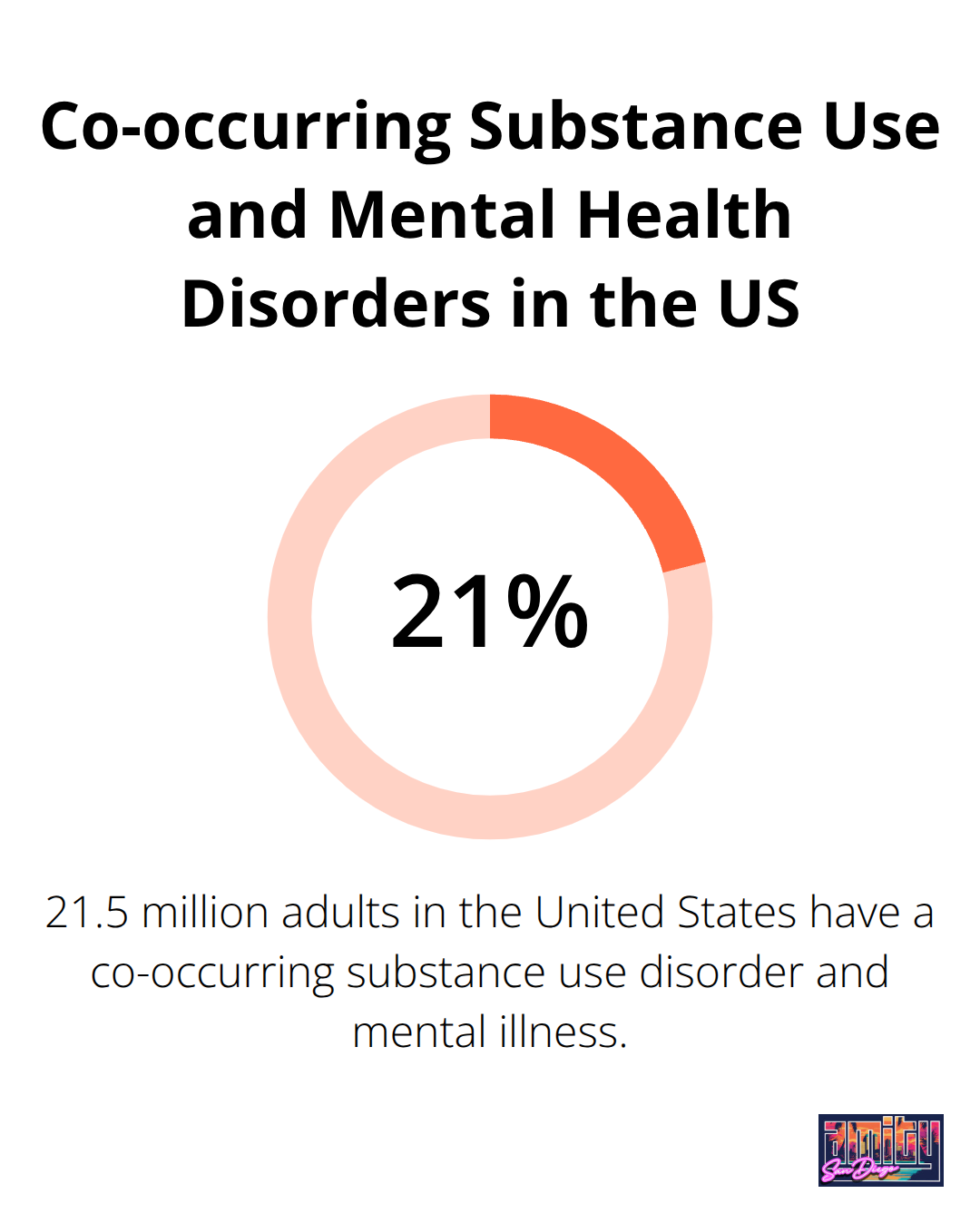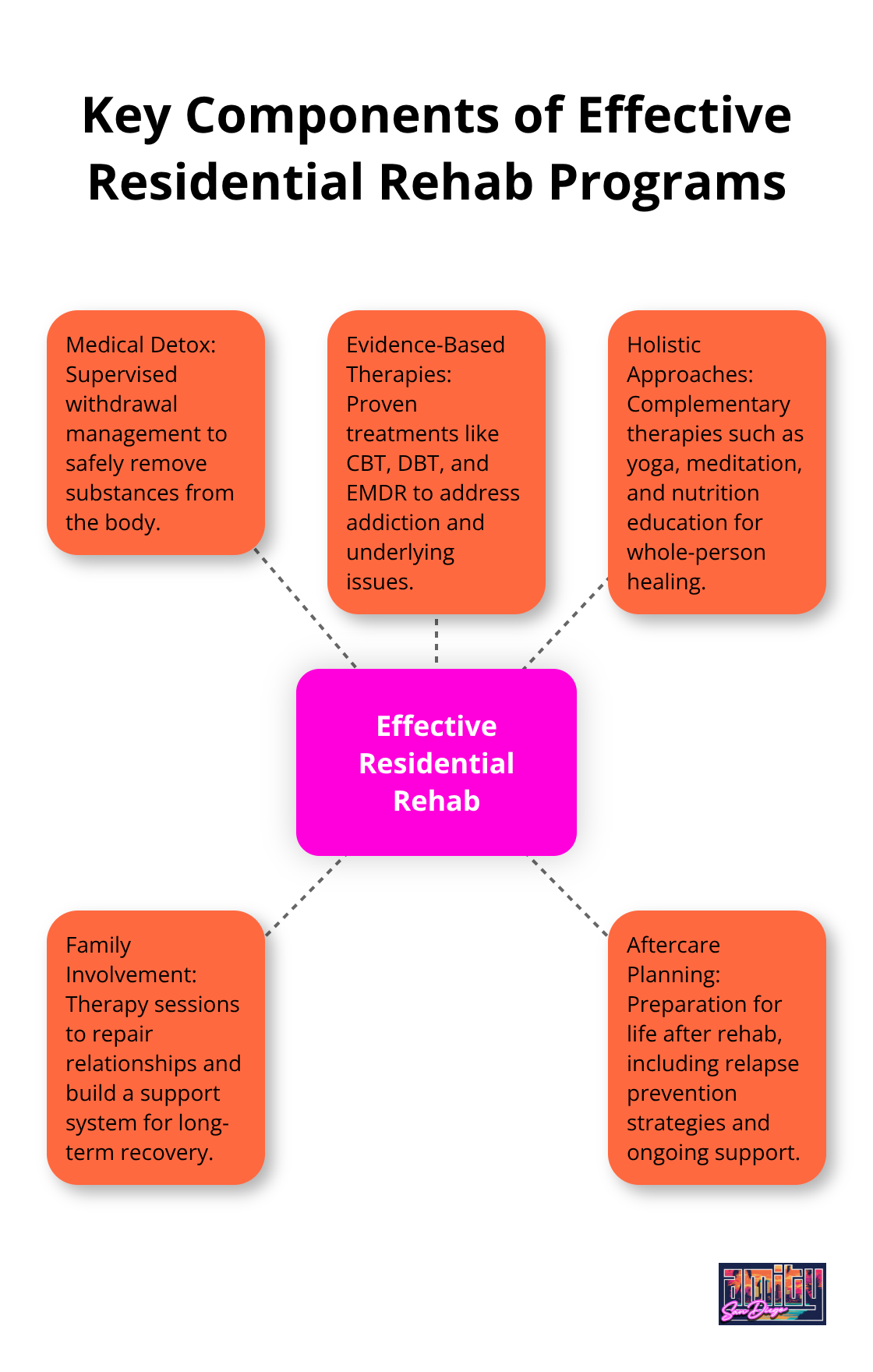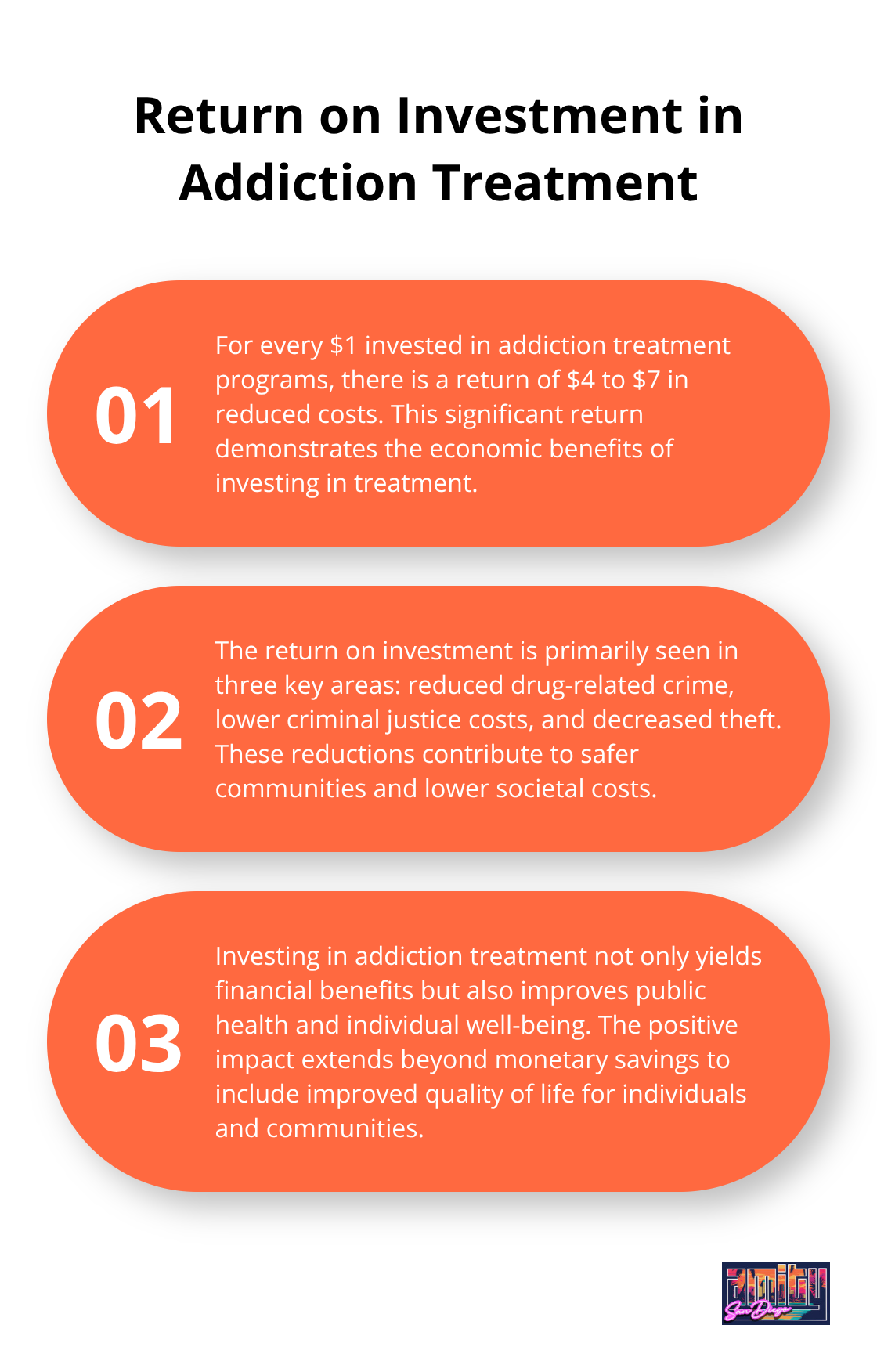At Amity San Diego, we understand the challenges of overcoming addiction. Residential rehabilitation treatment programs offer a powerful path to recovery, providing comprehensive support in a structured environment.
These programs remove individuals from triggers and negative influences, allowing them to focus entirely on their healing journey. In this post, we’ll explore the benefits of residential rehab, its key components, and how to choose the right program for your needs.
Why Residential Rehab Works
Round-the-Clock Support
Residential rehab programs transform addiction recovery. At Amity San Diego, we witness how these intensive, immersive experiences create lasting change. Trained professionals provide support, guidance, and medical care 24/7. This constant presence proves crucial during early recovery stages when cravings and withdrawal symptoms peak.
Research indicates that most individuals who receive and remain in treatment stop misusing drugs and alcohol, reduce their criminal activity, and improve their occupational, social, and psychological functioning. The structured environment helps patients develop coping skills and strategies to maintain sobriety long-term.
A Clean Slate
Residential rehab removes patients from triggers and negative influences. This physical separation from people, places, and situations that fueled addiction allows complete focus on recovery. Without distractions and temptations of the usual environment, patients can concentrate on healing.
Comprehensive Care at Your Fingertips
Residential programs offer a wide range of treatments and therapies in one place. From medical detox to individual counseling, group therapy, and holistic approaches (like yoga and meditation), patients access a full spectrum of care. This integrated approach addresses not just the addiction itself, but also underlying mental health issues or trauma that may contribute to substance use.
According to SAMHSA’s 2022 National Survey on Drug Use and Health, approximately 21.5 million adults in the United States have a co-occurring substance use disorder and mental illness. Residential programs uniquely handle these complex cases.

Building a Recovery Community
Residential rehab provides invaluable peer support opportunities. Patients surround themselves with others who understand their struggles and work towards similar goals. This sense of community breaks the isolation often associated with addiction.
Tailored Treatment Plans
Effective residential rehab programs create individualized treatment plans. These plans consider each patient’s unique needs, history, and goals. By tailoring the approach, residential programs increase the likelihood of successful recovery.
The intensive nature of residential rehab provides time, space, and resources for lasting changes. While it requires significant commitment, these programs often lead to more robust and sustainable recovery outcomes. As we explore the components of effective residential rehab programs, you’ll see how each element contributes to a comprehensive recovery journey.
What Makes Effective Residential Rehab Programs?
At Amity San Diego, we’ve witnessed how well-designed residential rehab programs transform lives. These programs combine several key elements to create a comprehensive recovery experience.

Medical Detox: The First Step
Medical detoxification often marks the beginning of treatment. This process typically lasts 3-7 days (depending on the substance and individual factors).
During detox, medical professionals monitor vital signs and manage withdrawal symptoms. They may use medications to ease discomfort and cravings. For example, doctors might prescribe buprenorphine or methadone for opioid withdrawal, while benzodiazepines can help manage alcohol withdrawal symptoms.
Evidence-Based Therapies: The Core of Treatment
After detox, patients engage in intensive therapy. Cognitive Behavioral Therapy (CBT) forms the cornerstone of many programs. CBT helps patients identify and change negative thought patterns and behaviors related to substance use.
Dialectical Behavior Therapy (DBT) proves effective, especially for those with co-occurring disorders. DBT teaches mindfulness, distress tolerance, and emotional regulation skills. Eye Movement Desensitization and Reprocessing (EMDR) addresses trauma, a common underlying factor in addiction.
Holistic Approaches: Healing the Whole Person
Many residential programs now incorporate holistic therapies. Yoga and meditation reduce stress and improve overall well-being.
Nutrition plays a vital role in recovery. Many individuals enter treatment malnourished due to substance abuse. A balanced diet helps repair physical damage and stabilize mood. Some programs offer cooking classes to teach healthy meal preparation skills.
Family Involvement: Healing Relationships
Family therapy forms a vital component of effective treatment. It helps repair damaged relationships and builds a support system for long-term recovery. Family involvement can positively affect client engagement, retention, and outcomes in substance use disorder treatment.
Aftercare Planning: Preparing for Life After Rehab
Successful programs start planning for aftercare from day one. This might include arranging outpatient therapy, connecting patients with local support groups, or helping secure sober living arrangements.
Relapse prevention training forms a critical part of aftercare. Patients learn to identify triggers, develop coping strategies, and create a plan for handling high-risk situations. This preparation proves essential for maintaining long-term sobriety.
As we explore how to choose the right residential rehab program, you’ll discover how these components come together to create a personalized and effective recovery journey.
How to Choose Your Ideal Residential Rehab Program
Assess Your Unique Needs
Start with an honest evaluation of your situation. What substances do you struggle with? Do you have any co-occurring mental health conditions? Are there specific therapies that interest you? Create a list of your priorities and non-negotiables.
The Substance Abuse and Mental Health Services Administration (SAMHSA) reports on national estimates of substance use, mental health, and treatment in the United States. Your specific needs within this diverse group will shape your ideal treatment plan.
Verify Credentials and Accreditations
Search for programs accredited by recognized organizations like the Commission on Accreditation of Rehabilitation Facilities (CARF) or The Joint Commission. These accreditations ensure the facility meets high standards of care.
Check the qualifications of the staff. Does the team include board-certified addiction specialists? Licensed therapists? A mix of medical professionals and counselors with personal recovery experience often provides the most comprehensive care.
Examine Treatment Approaches
Different programs have different philosophies. Some focus heavily on 12-step methods, while others use primarily evidence-based therapies like Cognitive-Behavioral Therapy (CBT).
Ask about the specific therapies offered and the daily schedule. A well-rounded program should include individual therapy, group sessions, and holistic activities. The National Institute on Drug Abuse states that effective treatment addresses multiple needs of the individual, not just their drug use.
Consider Practical Factors
Location matters. Some people benefit from proximity to home for family involvement, while others need distance from triggers. Think about what environment will best support your recovery.
Program length is another important factor. While 30-day programs are common, research shows that longer stays often lead to better outcomes. The National Institute on Drug Abuse recommends at least 90 days for most individuals.
Navigate Financial Options
Don’t let cost deter you from seeking help. Many insurance plans now cover addiction treatment due to the Mental Health Parity and Addiction Equity Act. Contact your insurance provider to understand your coverage.
If you’re uninsured or underinsured, explore other options. Some facilities offer sliding scale fees or payment plans. State-funded programs might be available (though they often have waiting lists).
Investing in your recovery is investing in your future. The National Institute on Drug Abuse estimates that every dollar invested in addiction treatment programs yields a return of between $4 and $7 in reduced drug-related crime, criminal justice costs, and theft.

Final Thoughts
Residential rehabilitation treatment programs provide a powerful path to recovery. These intensive programs transform lives by removing individuals from triggers and negative influences, allowing them to focus entirely on healing. Round-the-clock support from trained professionals, access to various therapies, and the opportunity to build a supportive community with peers contribute to successful recovery outcomes.
Addiction requires expert intervention and support. Residential rehab programs offer comprehensive care to address substance use, underlying mental health issues, and trauma that may contribute to addiction. The immersive nature of these programs provides the time and space needed for lasting change.
We at Amity San Diego offer personalized, evidence-based treatment in a compassionate environment. Our team of experienced professionals supports you throughout your recovery journey. If you’re ready to start your path to recovery, we encourage you to reach out to us. Take the first step today and reclaim your life from addiction.

